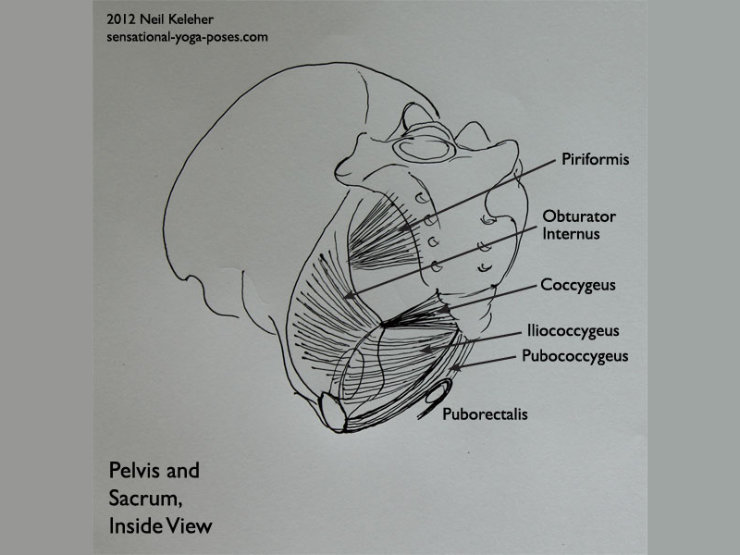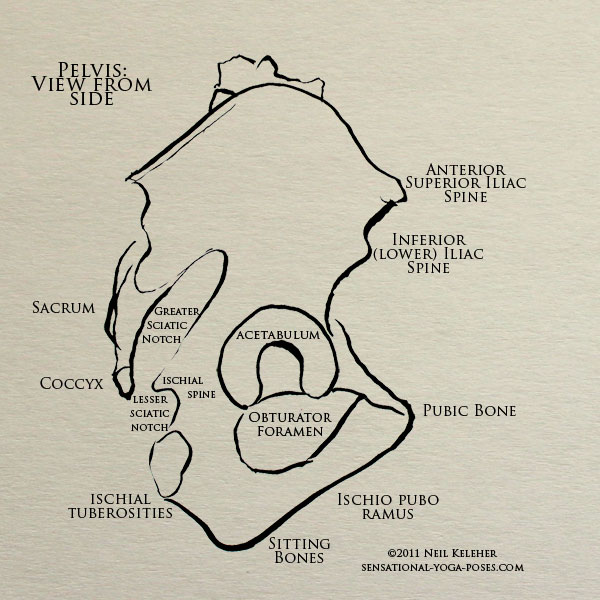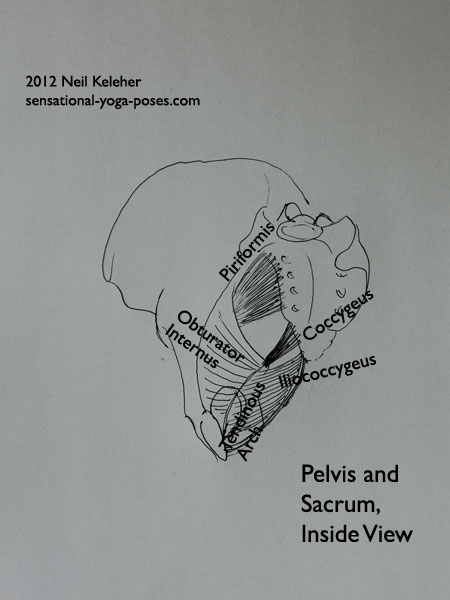Simple instructions for activating the PC muscle
One of the main pelvic floor muscles is the pubococcygeus or PC muscle. It connects from the tailbone at the bottom of the sacrum to the pubic bone.
Most instructions for activating the PC muscle describe "stopping the flow of urine" but another instruction for consciously activating it is pulling the tailbone towards the pubic bone. Rather than tilting the pelvis backwards to move the tailbone forwards, keep the pelvis still and move your tailbone towards your pubic bone (which is at the front of the pelvis.)
When doing this you may actually feel your tail bone moving forwards slightly (towards your pubic bone).
Control (and Sensitivity) is the Goal
The goal of learning to contract these pelvic floor muscles is not to hold them contracted, but to be able to contract them and release them at will. You may then be able to notice when you are overly "tight" without needing to be so. And you can also then choose to engage if what you are doing requires you to do so.
In a yoga pose context, greater awareness of the pelvic floor muscles can give better control of the SI joint, meaning control of how the sacrum and pelvis relate. It can also give a better sense of mula bandha.
Learning to relax and contract the PC muscle (and the rest of the pelvic floor) can be a starting point for developing better pelvic floor awareness.
Pelvic Landmarks
Before we continue it's a good idea to get to know some landmarks of the pelvis.
The Ischial Spine
If you are up on your hip bone anatomy then you know that the upper sciatic notch is the gap that the piriformis passes through as it runs from the front of the sacrum to the top of the thigh bones. The lower sciatic notch is the gap that the obturator internus wraps around.
The obturator internus attaches to the inside of the pelvis. It wraps around the back of the pelvis at the lower sciatic notch and then reaches forwards and up to attach to the top of the thigh bone. Meanwhile the piriformis passes from the sacrum to the thigh bone just above it.
The ischial spine acts as a sort of separator between the piriformis and the obturator internus where they both cross the back of the pelvis.
Piriformis and obturator internus aside, the ischial spine is just above (and behind) the sitting bone. The sitting bone then serves as a useful reference for learning to find and activate the coccygeus muscle.
The Tendinous Arch
Another important landmark is the tendinous arch. This arch of connective tissue runs from the ischial spine to the pubic bone and arches over the obturator internus muscle as it does so.
It's important because from the tailbone, the iliococcygeus muscle attaches to it.
The Anus and Perineum
Next as landmarks are the anus and the point just in front of the anus which I'll term the perineum.
The levator ani, which attaches to the back of the pubic bone, loops around the anus meaning that it can be used to pull the anus forwards. Meanwhile, looping in front of the anus is the levator prostatae/vaginae.
All of the above landmarks are important since they can be used as references for activating the individual muscles of the pelvic diaphragm.
Activating the Muscles of the Pelvic Diaphragm
I've already mentioned that to activate the PC muscle, all you have to do is pull the tailbone towards the pubic bone. You do this without moving the pelvis.
Activating levator ani and levator prostatae or levator vaginae
With the pubococcygeus already activated, you can pull forwards on the anus to activate levator ani. Then pull forwards on the perineum to activate levator prostatae or vaginae.
If you like you could also add a slight uddiyana bandha to this action by pulling inwards on the lower belly just above the pubic bone. Try to inhale while keeping all of these muscles active and then as you exhale gradually relax them completely.
Activating coccygeus and iliococcygeus
To activate coccygeus and ilio coccygeus, pull inwards on the sitting bones and then extend the tension forwards to the pubic bone. Play with the sequence in which you activate these muscles. You might try activating the center line first and then the more lateral coccygeus and iliococcygeus. Or try first activating the PC muscle, then the lateral muscles, then levator ani and prostatae/vaginae.
You can also try "sequenced" release of all of these muscles or simply relax them all together, but slowly and smoothly.
Activating the piriformis
Note that although piriformis isn't part of the pelvic floor (though it closely relates) you could also try activating this muscle by pulling forwards on the sacrum. It can feel like "sucking" the sacrum forwards.
I'd suggest doing this after activating the other muscles.
The pelvic floor muscles and SI joint stability
Generally, when we activate our pelvic floor muscles, we create a forwards pull on the tailbone (towards the pubic bone) and an inwards pull on the sitting bones. This can be used to nod the sacrum backwards, or counter-nutate it. If the sacrum is nodded forwards, i.e. nutated, then the pelvic floor muscles could be used to resist further nutation, or simply to help keep the SI joints stable while the sacrum is nutated.
So rather than saying that the pelvic floor muscles are only activated when the sacrum is counter nutated, it may be better to think of the pelvic floor muscles as being able to activate whether the sacrum is nutated or counter nutated. What you then have is a set of muscles that can be used in opposition to the lower band of the transverse abdominis and or the lumbar multifidius to stabilize the SI joints whether the sacrum is nodded forwards or backwards.
That being said, you may find that you can get a stronger pelvic floor activation when the sacrum is nodded backwards. And you may find that in this position it's easier to pull the lower belly in. Or it may actually pull inwards of its own accord when you activate your pelvic floor muscles.
For more on the nodding the sacrum forwards read SI Joint Exercises.
What type of poses can benefit from pelvic floor muscle activation
As to when it is best to nod the sacrum forwards (and spread the sitting bones) or nod it back (and retract the sitting bones), in my experience so far, it seems that spinal back bends are best accompanied by nodding the sacrum forwards. This means flicking the tailbone back, away from the pubic bone and spreading the sitting bones.
Meanwhile, spinal forward bends are best accompanied by nodding the sacrum rearwards. This means pulling the tailbone towards the pubic bone and pulling the sitting bones inwards.
That being said, I still like to experiment.
Now you might ask, what about if you are bending forwards or backwards at your hips?
One idea that might help in this regard is viewing the sacrum as part of the spine. Whatever your lumbar spine is doing, have the movement of your sacrum compliment that.
- So if back-bending the lumbar spine, then nutate the sacrum, stretch the pelvic floor muscles (while actively resisting).
(In other words, nod the sacrum forwards)
- If forward bending the lumbar spine (or flattening the lumbar lordosis) then counter-nutate the sacrum.
(Nod the sacrum rearwards)
What should the SI joints do when adducting or spreading the legs sideways?
For poses like side splits, whether or not the sacrum tilts forwards or backwards, can depend on whether your leg bones are rotated externally or internally. It can even depend on what you are doing with your lower legs and feet. That's because some of the muscles that rotate the shins attach from the shins to the corner points of the hip bones. And these can have an affect on the SI joints as well, since they can exert a pull on the hip bones. And so rather than saying you should nutate or counter-nutate, a better answer is to learn to feel both actions, so that you can figure out the best option for yourself.
What should the SI joints be doing in front to back splits
As for front to back splits, what should the SI joints be doing then?
I'd say here that one reason that we have SI joints, and muscles like the pelvic floor muscles, is so that we can do actions like side splits and front splits (and front bends and back bends).
With front to back splits, one SI joint can be nutated, and the other counter-nutated. Here again, depending on how you are using your shins and feet, you may find it more effective to counter-nutate the front leg SI joint and nutate the back leg SI joint. What that can mean is pulling the front leg sitting bone inwards and the back leg sitting bone outwards.
But here again, if you have control of your SI joints, or at the very least can feel your sitting bones, you can experiment. Which allows you to go deeper without causing pain or discomfort either while doing the splits or sometime afterwards?





